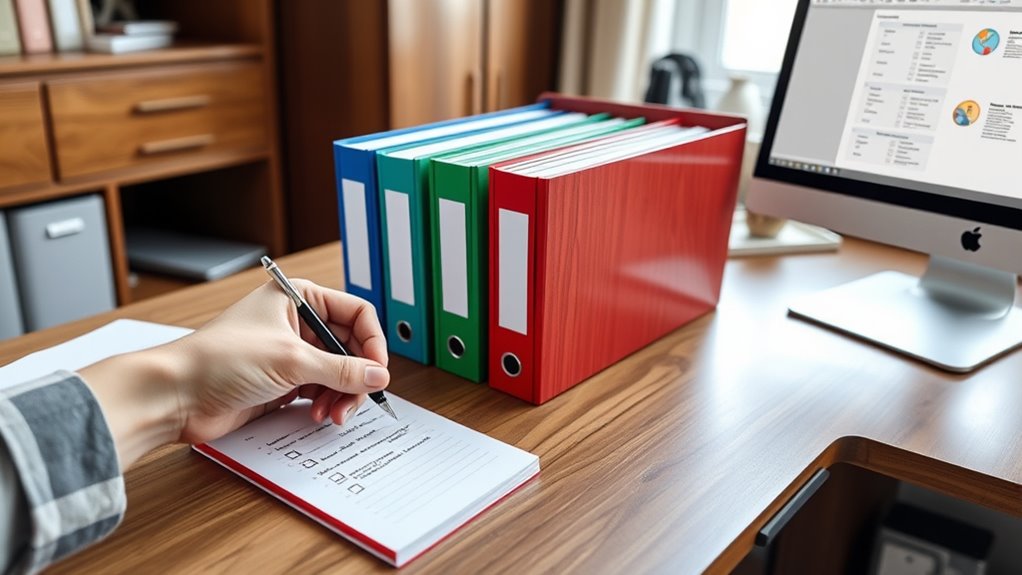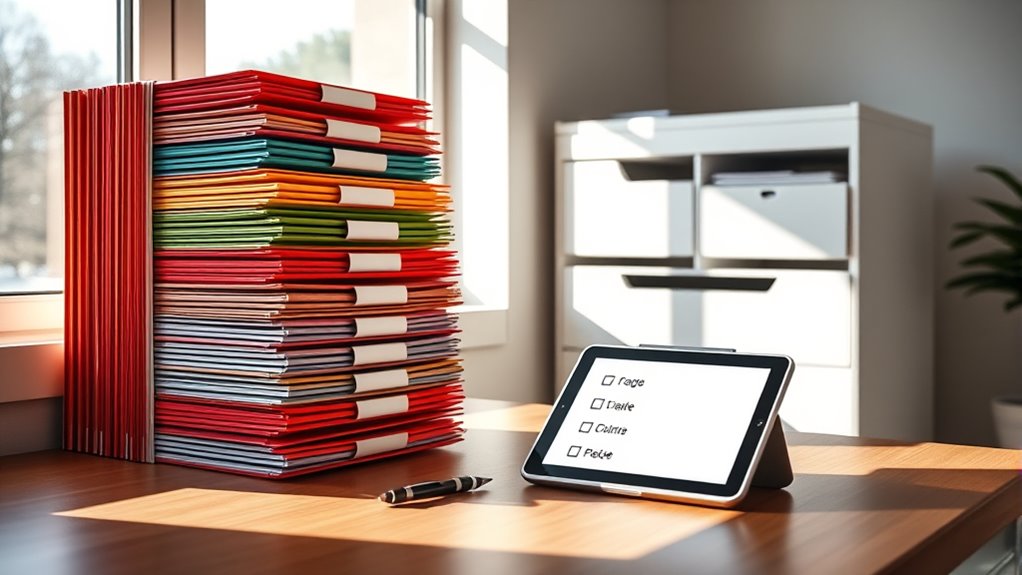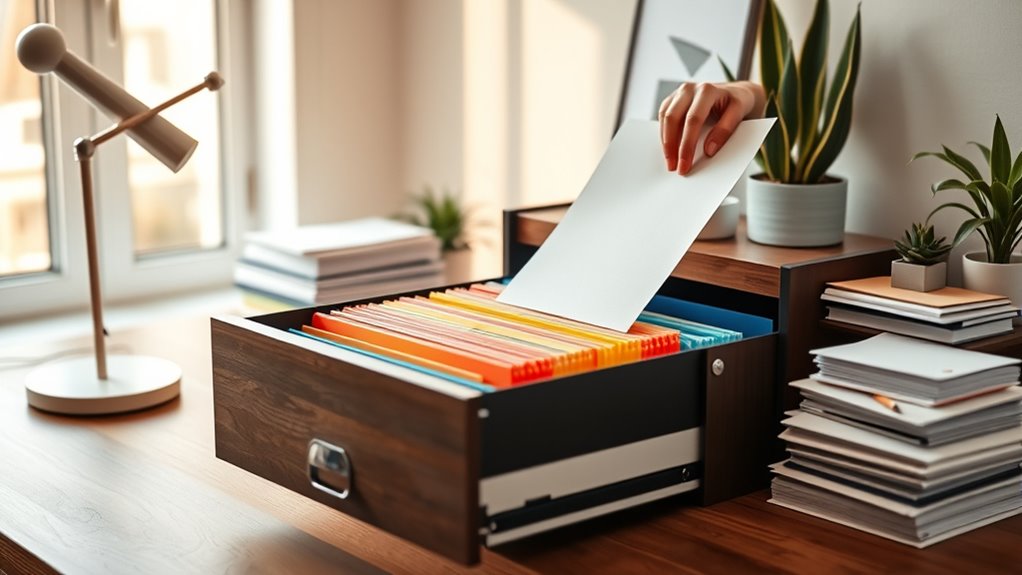Start by evaluating your document needs to decide what to keep and how to store it, considering both digital and physical options. Choose sturdy filing supplies like lockable cabinets, labeled folders, and color-coding to improve organization. Design a system that’s easy to access, and develop a routine to regularly update, sort, and shred outdated papers. With these steps, you’ll create an efficient home filing system that keeps your space tidy—more tips await as you continue.
Key Takeaways
- Assess and declutter existing documents to determine what to keep physically or digitally.
- Choose durable, lockable filing cabinets and organize supplies like folders and labels for efficiency.
- Design a system with clear labels, color coding, and accessible placement for quick retrieval.
- Incorporate digital backups and schedule regular reviews to update, shred outdated files, and maintain organization.
- Personalize your filing system to suit your needs, ensuring privacy, easy access, and long-term sustainability.
Assessing Your Document Needs

Have you ever wondered which documents you truly need to keep and for how long? Evaluating your document needs begins with reviewing your current files. Think about important papers like tax records, medical documents, and legal papers. Consider whether digital storage could help you organize and save space—scanning documents allows you to keep digital copies instead of physical clutter. Decide which documents are essential to retain physically and which can be stored securely online. Be realistic about your storage capacity and future needs. Removing outdated or unnecessary papers frees up space and simplifies your filing system. Practicing mindful decluttering strategies can help you make more intentional choices about what to keep and what to discard. By carefully appraising your document types and considering document scanning and digital storage options, you’ll create a more efficient, manageable home filing system tailored to your needs.
Choosing the Right Filing Supplies

Choosing the right filing supplies is key to keeping your documents organized and accessible. You’ll want durable filing cabinets that last and appropriate folder types to suit different documents. Don’t forget to label and organize everything clearly to make future retrieval quick and easy. Incorporating digital literacy programs can also help in managing digital documents alongside physical files.
Durable Filing Cabinets
Selecting durable filing cabinets is essential for creating a reliable home filing system that stands up to daily use. A sturdy cabinet guarantees your files stay secure and organized, supporting file security and protecting against damage. When choosing, consider features like lockable drawers for added security and materials that resist wear. Look for cabinets with smooth-gliding rails for easy access. Remember, a solid cabinet can complement digital backups by providing a physical space to store important documents safely. Incorporating robust construction ensures the longevity and durability of your filing system.
Appropriate Folder Types
To keep your files well-organized and easily accessible, it’s important to pick the right folders and filing supplies. Choose folders suited for paper categorization, such as manila folders for general documents or color-coded ones for quick identification. If you handle digital storage, consider labeled folders on your computer to mirror physical filing for consistency. Clear, sturdy folders help protect important papers, while expandable folders accommodate growing collections. Use different types based on your needs:
| Folder Type | Best For | Features |
|---|---|---|
| Manila Folders | General paper documents | Durable, easy to label |
| Hanging Folders | Office drawers, files | Easy access, keeps papers organized |
| Pocket Folders | Temporary storage, handouts | Compact, portable |
| Expandable Folders | Long-term storage, multiple categories | Spacious, flexible |
Matching folder types to your storage needs streamlines paper and digital organization. Additionally, incorporating visual cues can further enhance your filing system’s efficiency by making it easier to locate documents at a glance.
Labeling and Organization
Effective labeling and organization start with the right filing supplies that suit your needs. Choosing quality tools guarantees your system stays clear and easy to maintain. When it comes to file labeling, opt for durable labels that resist smudging and fading. Color coding is a great way to quickly identify categories at a glance, so select a set of vibrant, consistent colors. Consider using label makers for neat, professional labels, and invest in sturdy file folders with clear tabs for easy viewing. Additionally, you might want dividers to separate sections and a labeling system guide for consistency. Keep these supplies organized in a dedicated storage container to streamline your filing process. Proper supplies make your home filing system more efficient and less frustrating.
Designing Your Filing System

Designing your filing system begins with understanding how you process and retrieve information. Consider whether you prefer digital storage or paper files, and how accessible you need each for quick retrieval. An ergonomic design helps reduce strain and makes your system more efficient. Use a table like this to decide your priorities:
| Priority | Approach | |
|---|---|---|
| Easy access | Label folders clearly; keep frequently used documents within reach | |
| Space efficiency | Choose compact storage solutions; utilize vertical space | |
| Digital integration | Incorporate digital backups and scans for important papers | Modern filing systems often benefit from digital integration, allowing for easier backup and quick search capabilities. |
Sorting and Categorizing Your Papers

Start by grouping similar documents together to make your filing easier to manage. Use clear, descriptive labels for each category so you can find papers quickly. This step keeps your system organized and saves you time in the long run. Incorporating effective organization strategies can further enhance the efficiency of your filing system.
Group Similar Documents
As you begin sorting your papers, it’s helpful to group similar documents together to make the process more manageable. This step keeps your filing system organized and simplifies retrieval later. Start by sorting through bills, receipts, medical records, warranties, and important correspondence. Consider creating categories like finances, health, legal, and personal documents. For added security, digitize important papers and store digital backups safely. Once you’ve grouped related documents, decide which papers are no longer needed; paper shredding helps reduce clutter and protects sensitive information. Keep in mind that consistent grouping makes future updates easier and ensures you won’t miss critical files. Organizing your papers into clear categories is a key step toward a streamlined, efficient home filing system. Utilizing data analysis techniques can further optimize your organization process by identifying which documents are accessed most frequently.
Use Clear Labels
Clear labels are essential for quickly finding and managing your documents. When you label folders and files clearly, you save time and reduce frustration. Use specific, descriptive words that reflect the contents, like “Tax Returns 2023” or “Medical Bills.” Incorporate digital storage by labeling scanned documents with similar clarity, making them easy to locate later. Document scanning helps you create digital copies, so labeling these files consistently guarantees seamless organization across both paper and digital formats. Avoid vague labels like “Misc” or “Stuff.” Instead, be precise. Clear labels help you stay organized, whether you’re sorting physical papers or digital files, ensuring everything is accessible and manageable at a glance. Proper labeling keeps your home filing system efficient and easy to maintain. Additionally, understanding skin type considerations can help tailor your organization system to better suit your needs for handling sensitive or easily damaged documents.
Labeling and Color-Coding

Labeling and color-coding are essential steps to creating an organized and efficient home filing system. Using clear label placement techniques guarantees you can quickly identify files, while color coding schemes add visual cues for easy sorting. Choose colors that represent categories, such as red for urgent documents or green for financial files. Consistency is key—stick to your chosen scheme across all folders. When applying labels, position them where they’re most visible, like the top or front of folders. Consider using labels with large fonts and bold text for better readability. Incorporating these methods helps you locate files faster. Remember, a well-structured color coding system and strategic label placement can streamline your entire filing process. Additionally, understanding the science of attractiveness can motivate you to maintain a clean and appealing organization system that enhances your home environment.
Establishing a Maintenance Routine

Once you’ve set up your home filing system, establishing a regular maintenance routine guarantees it stays organized and functional. Schedule weekly or biweekly check-ins to review files and ensure everything remains in order. Incorporate digital backups of important documents to prevent data loss; regularly update these backups to reflect recent changes. Implement a shredding schedule to dispose of outdated or sensitive documents securely, freeing up space and reducing clutter. Consistently label and file new paperwork immediately to avoid backlog. Keep an eye out for misplaced items and reorganize as needed. Incorporating predictive analytics can help identify potential organization issues before they arise. By sticking to this routine, you’ll maintain a tidy, efficient system that minimizes stress and saves time when you need important documents. Regular upkeep keeps your filing system reliable and easily accessible.
Tips for Staying Organized Long-Term

Maintaining long-term organization requires consistent effort and proactive strategies. To stay on top of your filing system, develop routines like updating digital backups regularly and adhering to shredding protocols for sensitive documents. These habits prevent clutter buildup and protect your privacy.
Long-term organization needs ongoing effort and proactive habits like regular digital backups and shredding protocols.
Consider these tips:
- Schedule monthly reviews to purge outdated files
- Digitize important documents to reduce paper clutter
- Implement shredding protocols for sensitive info
- Use clear labels and color-coding for easy retrieval
- Keep a dedicated space for incoming papers to prevent backlog
Staying organized isn’t a one-time task; it’s about creating habits that support your system’s efficiency. By combining digital backups with disciplined shredding and consistent maintenance, you’ll keep your home filing system streamlined and manageable long-term.
Frequently Asked Questions
How Often Should I Review and Update My Filing System?
You should review and update your filing system at least once every six months. Regular document organization and filing maintenance help guarantee everything stays current and accessible. When you check your system, discard outdated papers and reorganize as needed. This routine prevents clutter, keeps your files relevant, and makes finding important documents easier. Consistent updates also reduce stress and save time when you need to locate specific files quickly.
What Digital Alternatives Can Complement My Physical Filing System?
Imagine your filing system as a garden—you want it to flourish and stay tidy. Digital organization tools like cloud storage act as your garden’s watering system, keeping files accessible and safe. By integrating digital alternatives, you can effortlessly back up important documents, reduce clutter, and streamline retrieval. Cloud storage complements your physical files, ensuring you’re always prepared, no matter where life takes you.
How Do I Securely Dispose of Sensitive Documents?
To securely dispose of sensitive documents, follow shredding protocols by using a cross-cut shredder for thorough destruction, preventing identity theft. After shredding, consider secure storage options like lockable bins or safes until you can dispose of the materials. Make sure to shred documents containing personal information, financial details, or confidential data regularly, and never toss unshredded sensitive papers in regular trash to maintain your privacy.
Can I Incorporate a Mobile or Portable Filing Option?
You can definitely incorporate mobile organization by using portable storage options, making it easy to access and transport your files. Portable file boxes, rolling carts, or electronic storage devices let you keep important documents handy and secure on the go. This flexibility helps you stay organized, whether at home or elsewhere. Just guarantee your portable storage is sturdy and secure to protect sensitive information while maintaining convenience.
How Do I Handle Outdated or Duplicate Files Effectively?
Outdated or duplicate files can feel overwhelming, like clutter in your digital organization and paper archiving efforts. You should regularly review your files, deleting duplicates and archiving outdated documents. Use clear labels and consistent naming conventions to stay organized. Digitize important paper files for easier management and backup. This approach helps you maintain a streamlined system, making both digital organization and paper archiving more efficient and less stressful.
Conclusion
With your home filing system in place, you’ll find organization becomes second nature—like riding a bike downhill. Keep your system maintained and stay consistent, and clutter won’t stand a chance. Think of it as tending a garden; with regular care, your documents will flourish in neat, easy-to-access rows. Soon, you’ll breeze through your papers, feeling more in control and less overwhelmed. Your organized home is just a few simple steps away—happy filing!









